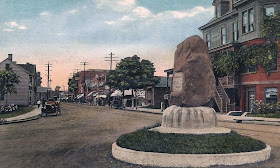Hillsborough friends and neighbors who commute to New Brunswick and points east are no doubt rejoicing today over the reopening of the canal bridge over the Millstone River. But did you know that as you travel Amwell Road near the intersection of Clyde you'll pass the epicenter of an epic animal rights battle that took place over a century ago?
 |
| Rockefeller Institute. New York |
By 1907, the four-year-old Rockefeller Institute for Medical Research had come to the realization that midtown Manhattan was not the most desirable location to carry out scientific experiments concerning contagious and life-threatening diseases - especially those involving animal dissection, a large focus of the research. Directors were beset by problems right from the start, not the least of which was how to obtain animals suitable for vivisection.
 |
| New York Herald, October 20, 1907 |
Neighborhood boys, lured by the promise of fifty cents per pooch, terrorized the upper east side in their quest for terriers. It got so bad that beleaguered pet owners knew to go immediately to the Institute pound upon realizing Fido was missing, where the dogs were always happily reunited with their masters. Some dogs were snatched and sold as many as five or six times - good money for the boys, but bad business for the Institute. Besides, constantly collecting "orphan" dogs gave no possibility to observe the effects of disease or medication on subsequent generations.
 |
| New York Herald, November 27, 1909 |
The obvious solution was to find a large farm in the country where animals could be kept and bred safely. The Rockefeller Institute settled on a 97-acre tract in the Clyde section of Franklin Township. The farm already contained numerous barns and other buildings, all of which were rehabilitated for the purpose of keeping animals. And there were plenty of animals.
The first residents were the dogs that came from the Institute's 66th Street pound. There were also sheep and goats and guinea pigs and rabbits and mice and monkeys. Some horses, some cows, chickens, and pigeons.
As recounted in the 1964 book A History of the Rockefeller Institute 1901-1953 by George W. Corner, the New York Herald's October 1907 six-column feature story about the farm was accurate and fair, but also suggested that vivisection on such a large scale would attract "universal attention" from antivivisectionists, and would become "the antivivisection storm centre of the world." A prediction that the Herald was committed to fulfilling, apparently, as they were the only New York daily on the side of the animal activists for the next several years!
 |
| New York Herald, January 1, 1910 |
On the other side, The Times, Sun, Evening Post, Tribune, and Collier's magazine, kept the protesters honest by debunking crazy claims of cruelty at the farm and highlighting the advances of in medicine coming out of the Institute. Still, New Jersey and New York were both ready with bills to outlaw vivisection as early as 1908 - and the battle raged on. After a suspected antivivisectionist protester set fire to many of the farm buildings, unwittingly killing many of the animals he sought to save, the Herald put forth the proposition that the incendiary's mind had been "unhinged" by reports of animal suffering.
The protesters began to lose ground by the end of 1909 when Mrs. Kennedy, a former farm employee who had sworn out an affidavit alleging the worst cruelties, was accused of bribing other employees to confirm her story. All along, scientists remained on the side of the Institute and helped to inform the public of the necessity of animal testing in scientific research.
According to Corner, the antivivisectionists actually helped the cause of science by forcing researchers to clearly and openly explain their goals and successes to the public. I might add that the pressure applied by animal rights activists on Amwell Rd. and around the country, while not ending animal research, undoubtedly led to the more humane treatment of the animals who have given their lives so that we might save ours.






.jpg)

.jpg)





.jpg)





.jpg)

.jpg)
.jpg)
.jpg)
.jpg)
.jpg)












